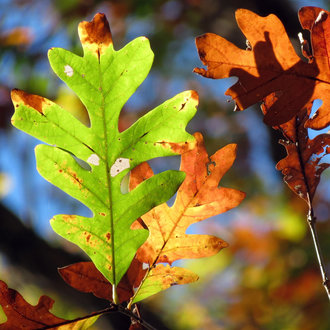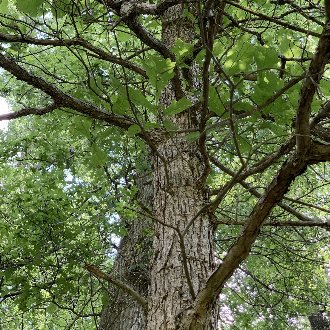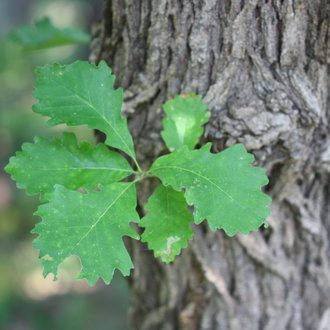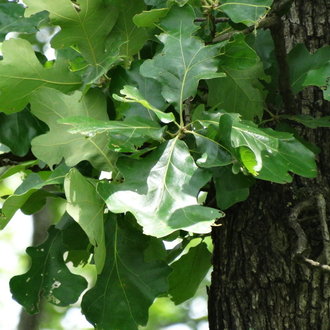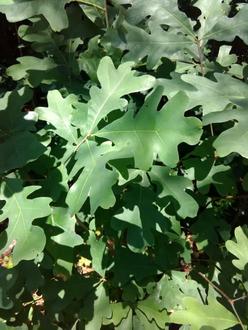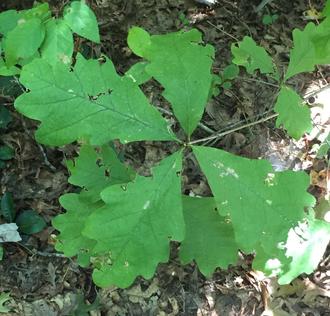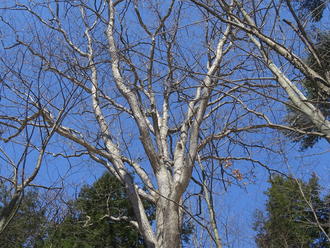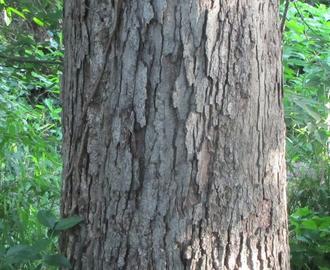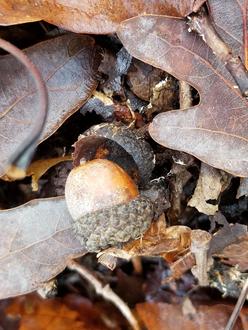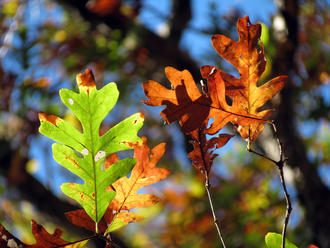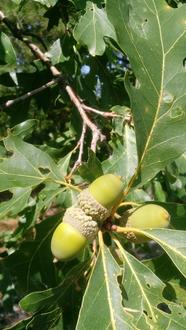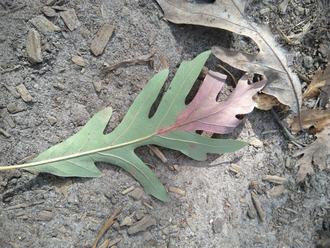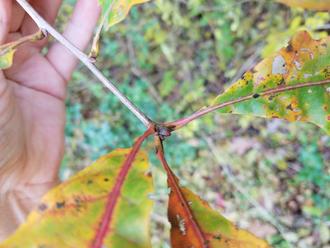White Oak (Quercus alba L.)
↑Summary
A widespread oak that is a key component of forests across eastern North America, often found in slightly dry conditions.
↑Range - Expand
| Legend | Color |
| Native | |
| Native or Not Present | |
| Expanded | |
| Native or Expanded |
This map is based on our research. We have checked its accuracy to Level 3 ecoregions. Although this plant occurs somewhere in each of these regions, it may only occur in a small part of some or all of them.
BONAP reports the populations in far southeastern South Dakota to be adventive; we mark them as expanded because they are adjacent to this species native range.
↑Description & Identification
A medium-to-large tree typically reaching 60-80ft (18-24 m) in height, to 100 feet (30 m) on favorable sites.
Leaves have rounded lobes, usually with 7-9 lobes per leaf; sinuses between lobes range from 1/3 the length to the midrib on shade-grown leaves, to 7/8 the length to midrib on leaves exposed to sunnier conditions. Leaves have cuneate (wedge-shaped) bases. Mature leaves are light gray-green and glabrous both above and below.
Bark of mature trees is light gray, scaly, and rough-textured.
↑Similar Plants
↑Habitat
Found in a wide variety of forest types, including uplands, bottomlands, dry slopes, and areas along streams, but absent from poorly-drained and very wet sites, and ridgetops with shallow soil. Typically found in dry-to-mesic sites. Grows best in deep, loamy soils, but adapts to a range of soil types and also commonly found on rocky soils. Typically found in areas that experience periodic fires, but at intervals less frequent than once every 8 years.
As this species has a broad range, its habitat preferences show considerable regional variation. In the southern Appalachians, prefers north-facing slopes at lower elevations. In the northeasternmost portions of its range, it is mostly limited to warmer, south- and west-facing slopes. Towards the west of its range it is found on relatively moister, richer sites. In the center of its range it is found on a wider range of sites.
Native Americans probably increased the habitat for this species through controlled burns, but fire suppression following European colonization has decreased its prevalence.
↑Life Cycle
White oak acorns germinate shortly after falling, and typically do not survive even a full year. There is no presence in the seed bank. The acorns require a cover of leaf litter, or being buried by animals, to survive; if germinating on the surface, plants are killed by frost or drought.
Seedlings establish an S-shaped curve at ground level, which protects dormant buds from fire.
Seedlings can persist under a closed forest canopy as long as 90 years, with above-ground parts dying back in the absence of sufficient light, but the root system continuing to develop. Increased light caused by an opening stimulates sprouting. Although this species is sometimes described as "slow-growing", plants with an established root system can grow quickly when released to higher-light conditions.
Trees typically begin producing seed around 50 years of age, but trees on open sites may begin seed production as young as 20 years. Production continues to around 200 years of age. Good seed crops (masting) are produced at irregular intervals, between 3 and 10 years. Typically the entire seed crop is eaten by animals during years of low production, and reproduction only occurs during masting years.
Trees top-killed by fire or mechanical damage often resprout from the stump or root system, but as trees grow older, their resprouting ability decreases. Trees as old as 80 years are able to resprout occasionally, whereas saplings and pole-sized trees resprout more reliably. Resprouting is rare among trees greater than 16 inches in diameter. Repeated fires or herbivory induces trees to produce root stools, hardened tissue full of dormant buds, which resprout vigorously when conditions are favorable. Sprouting is typically triggered by a combination of high light levels and removal of aboveground portions of the plant.
Trees are long-lived and often live up to 600 years.
↑Faunal Associations
Like other oaks, white oak supports a broad array of different insects that feed on its foliage and other parts of the tree.
Acorns of this and other species of the white oak group, particularly before they sprout, are a preferred food source for many animals, including many mammals and larger birds.
Deer and rabbits forage on the foliage of young trees. Porcupines feed on the bark, and beavers on the twigs of this species.
The structure of this tree also provides good cover for numerous animals, including birds and mammals. As the leaves persist longer than those of many deciduous trees, this cover is of high value in habitats where such cover is scarce. Larger trees are also used as dens and nesting sites for various mammals, and the twigs are used as nesting materials by both birds and mammals.
↑Uses
Sometimes used in landscaping as a large shade tree, where it is valued for its adapatability, drought tolerance, and resilience, particularly that damage in one limb is less likely to kill the whole tree than with some oaks. Its use in landscaping is complicated by the fact that it is difficult to transplant.
It has also been used in revegetation and restoration of land degraded by strip-mining.
An important timber species; the wood sells for a higher price than that of red oaks, reflecting both higher demand and lower supply. It is valued for its aesthetics, rot-resistance, and workability. Main uses are in cabinetry and furniture. The harvest of this species' wood is limited by its poor regeneration under traditional harvest regimes. Successful management for this species is possible, but can be rather complicated.
↑Related Plants
White oak is closely related to, and readily hybridizes with numerous other native species of the white oak grouping, including swamp white oak (Quercus bicolor), bur oak (Quercus macrocarpa), chinquapin oak (Quercus muehlenbergii), dwarf chinquapin oak (Quercus prinoides), overcup oak (Quercus lyrata), swamp chestnut oak (Quercus michauxii), sand post oak (Quercus margaretta), chestnut oak (Quercus montana), bastard oak (Quercus sinuata), and post oak (Quercus stellata).
It is also closely related to and able to hybridize with the introduced english oak (Quercus robur).
Oaks of the red oak group are related, but less closely, and do not hybridize with this species.
↑Notes
This species is sensitive to ground-level ozone, which can hinder its establishment and survival in urban areas.
↑Links & External Resources
• White Oak | The Wood Database (About This Site)
• White Oak | Fire Effects Information System (FEIS) (About This Site)
• Quercus alba (White Oak) | Illinois Wildflowers (About This Site)
• Quercus alba (White Oak) | USDA PLANTS Database (About This Site)
• Quercus alba | Go Botany (About This Site)
• Quercus alba (White Oak) | Missouri Botanical Garden Plant Finder (About This Site)
• White Oak | Virginia Tech Dendrology Factsheets (About This Site)
• White Oak | Silvics of North America (About This Site)
• Quercus alba | Biota of North America Project (BONAP) (About This Site)
• Quercus alba | NatureServe Explorer (About This Site)
• Quercus alba | Flora of North America (About This Site)
• White Oak | Maryland Biodiversity Project (About This Site)
• Quercus alba Linnaeus (White Oak) | Digital Atlas of the Virginia Flora (About This Site)



